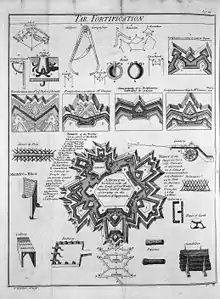Crownwork
A crownwork is an element of the trace italienne system of fortification and is effectively an expanded hornwork (a type of outwork). It consists of a full bastion with the walls on either side ending in half bastions from which longer flank walls run back towards the main fortress.[2]

A crownwork outside a bastion

Feature 'l' is a crownwork.[1]
The crownwork was used to extend the fortified area in a particular direction, often in order to defend a bridge, prevent the enemy occupying an area of high ground, or simply strengthen the overall fortifications in the expected direction of attack.[3]
See also
- The Kronverk, St Petersburg, Russia
Notes
- From the Cyclopaedia
- Griffiths 1862, p. 262.
- Editor 1830, p. 590.
References
- Griffiths, Frederick Augustus (1862). The Artillerist's Manual, and British Soldier's Compendium (9th ed.). Parker & Son.
- "A Popular View of Fortification and Gunnery, No. I. 49, No. II. 316, No. III. 586". The United Service Journal and Naval and Military Magazine. London: Henry Colburn and Richard Bentley. 1830.
This article is issued from Wikipedia. The text is licensed under Creative Commons - Attribution - Sharealike. Additional terms may apply for the media files.